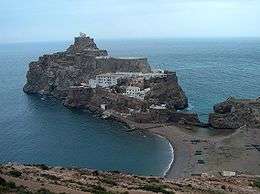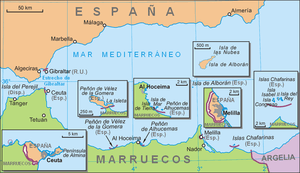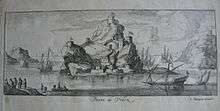Peñón de Vélez de la Gomera
Peñón de Vélez de la Gomera (Spanish pronunciation: [peˈɲon de ˈβeleθ ðe la ɣoˈmeɾa]; Berber language: Badis; Arabic: جزيرة غمارة jazīrat ghumara) is a Spanish exclave, a rocky tied island in the west of the Mediterranean Sea, connected to the Moroccan shore by a sandy isthmus. It is also connected to a smaller islet to the east, La Isleta, by a rocky isthmus.
 Peñón de Vélez de la Gomera, seen from the Moroccan coast. The smaller islet to the right, La Isleta, connected by a rocky isthmus, is also under Spanish sovereignty. | |
| Geography | |
|---|---|
| Location | Moroccan coast |
| Coordinates | 35°10′20″N 4°17′59″W |
| Adjacent bodies of water | Mediterranean Sea |
| Administration | |
Vélez de la Gomera, along with La Isleta, is a Plaza de soberanía, a premodern overseas possession, administered by the Spanish central government, and has a population consisting only of a small number of Spanish military personnel.
Geography

Peñón de Vélez de la Gomera is located 119 km (73.94 mi) southeast of Ceuta. It was a natural island in the Alboran Sea until 1934, when a huge thunderstorm washed large quantities of sand in the short channel between the island and the African continent, turning it into a tombolo.[1] Ever since, it has been a peninsula, currently connected to the Moroccan coast by an 85 m (278.87 ft) long sandy isthmus, the world's shortest single land-border segment.[2] With a length of 400 m (1,312.34 ft) northwest-southeast and a width of up to 100 m (328.08 ft), it covers about 19,000 m² or 1.9 ha.
History


Portugal and Spain passed an agreement in 1496 in which they effectively established their zones of influence on the North African coast: Spain could only occupy territory east of Peñón de Vélez. This restriction only ended with the Iberian Union of Portugal and Spain under Felipe II after the 1578 Battle of Ksar El Kebir, when Spain started to take direct actions in Morocco, as in the occupation of Larache.[3]
In 1508, Spain launched a successful expedition under the command of Pedro Navarro to take the Peñón located near Badis, held by pirates who were constantly attacking and looting the coast of Southern Spain.
In 1522, Spain lost the Peñón to a Moroccan Berber attack that resulted in the deaths of the whole Spanish garrison. Ali Abu Hassun, new ruler of the Kingdom of Fez in 1554, then gave the Peñón to Ottoman troops who had assisted him in gaining the throne.[3]
In 1564, after a failed attempt in 1563, the Spaniards under command of The 4th Marqués de Villafranca retook the Peñón, killing its garrison of 150 Ottoman soldiers. Mathurin Romegas took part in the capture, and the Seigneur de Brantôme was another witness to the event. Spain has retained control of it ever since, withstanding sieges in 1680, 1701, 1755, 1781 and 1790.
In 1871, the Spanish Congress debated abandoning the Peñón, since by that time it had lost its military role, but in the end, the proposal was dropped.
Government
Peñón de Vélez de la Gomera is governed by direct rule from Madrid.
Transportation
The territory is reached mostly by helicopter via a helipad located on the upper sections. A landing area is located on the south end near the land entrance to Peñón de Vélez de la Gomera.
See also
- Former island
- List of Spanish Colonial Wars in Morocco
- Morocco-Spain border
- Plazas de soberanía
- Spanish Protectorate of Morocco
References
- "Historia de Peñón de Vélez de la Gomera". Ejercito de Tierra (in Spanish). Archived from the original on 14 May 2009. Retrieved 29 October 2018.
- Lewis, Martin W. (30 Aug 2010). "The World's Shortest Border". GeoCurrents. Archived from the original on 11 Aug 2018. Retrieved 22 June 2019.
- Kissling, Hans Joachim; Spuler, Bertold; et al. (29 October 1996). The Last Great Muslim Empires: History of the Muslim World. Translated by Bagley, F. R. C. Princeton, New Jersey: Markus Wiener Publishers. p. 103. ISBN 978-1-55876-112-4. Retrieved 29 October 2018 – via Google Books.
External links
- Spanish Autonomous Communities at WorldStatesmen.org